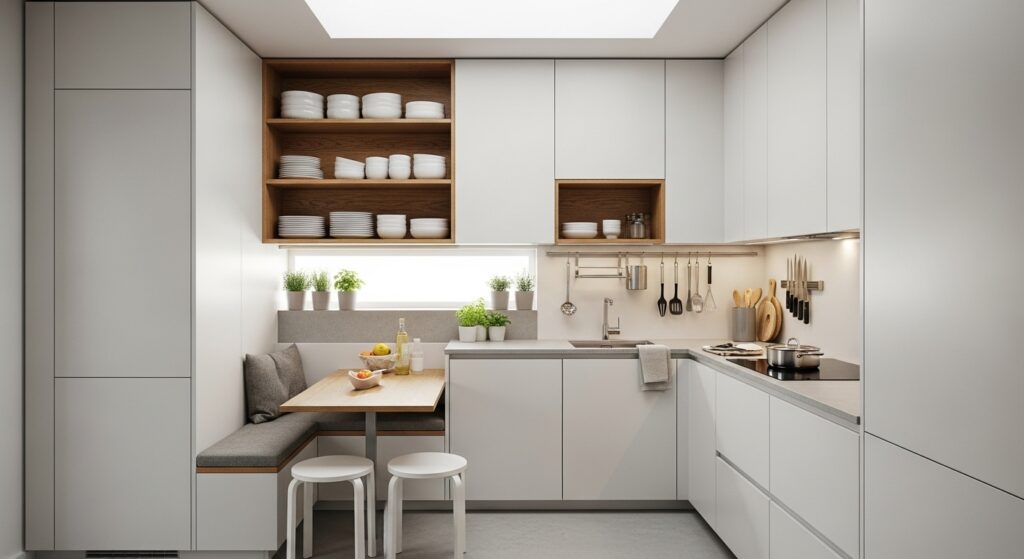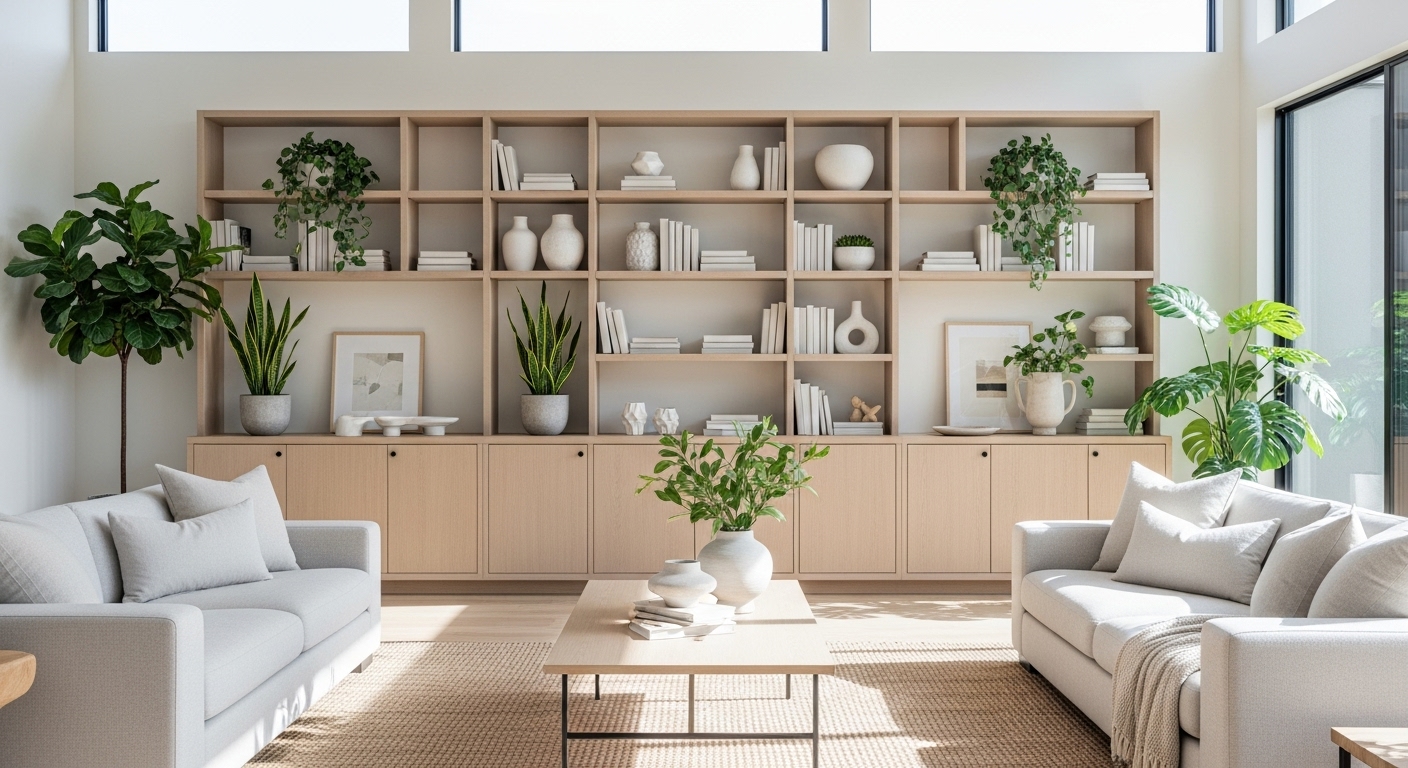In modern homes, floor space is often painfully limited, but vertical space design offers an elegant solution that transforms cramped rooms into organized, spacious-feeling environments. Vertical space design is not merely about utilizing unused wall area; it represents a fundamental shift in how we approach home organization and interior aesthetics. By implementing vertical space design strategies, you can maximize storage, enhance visual appeal, and create sophisticated interiors without compromising on style or functionality.
This comprehensive guide explores practical, creative, and visually stunning ways to transform vertical areas in every room—from living spaces and kitchens to bedrooms and bathrooms. By implementing these proven strategies, you can achieve a home that feels simultaneously open, impeccably organized, and undeniably sophisticated.

Understanding the Importance of Vertical Space Design
Vertical space design represents far more than simply stacking items on top of each other. Properly utilized verticality transforms how your home functions and feels psychologically. When implemented thoughtfully, vertical space design accomplishes multiple objectives simultaneously.
Strategic use of vertical areas creates a genuine sense of height and openness, particularly valuable in smaller rooms where floor space feels precious. Rather than spreading belongings horizontally across limited floor area, vertical space design directs attention upward, making rooms feel larger and more inviting than they actually are.
Beyond functionality, vertical space design adds dynamic visual interest. When you think vertically, your eye travels upward naturally, creating psychological spaciousness. Interior designers recognize that verticality is absolutely key to making small spaces feel larger, more organized, and genuinely inviting.
Creative Vertical Storage Solutions for Modern Homes
Implementing vertical space design begins with understanding available storage options. Floor-to-ceiling shelving units maximize storage without overwhelming your floor area. Whether you choose open shelving to display decorative items or closed cabinets for a cleaner aesthetic, tall shelving becomes the foundation of successful vertical space design.
Floating shelves represent another cornerstone of vertical space design, freeing floor space while providing exceptional functionality. Use floating shelves for books, potted plants, or carefully curated art pieces. Wall-mounted cabinets positioned above desks, beds, or appliances offer additional storage without sacrificing movement or flow throughout your space.
Lofted areas and elevated workstations exemplify how vertical space design enables dual-purpose rooms. Loft beds create distinct sleeping, working, and living zones vertically, proving especially effective in studios or children’s rooms where floor space is at a premium.
Hooks and pegboards provide accessible storage for tools, kitchenware, and accessories. This approach keeps frequently used items visible and immediately accessible while saving precious drawer and countertop space. Multi-functional furniture—such as beds with integrated drawers, modular wardrobes, or tall storage units—consolidates your belongings efficiently through intelligent vertical space design.

Styling Vertical Space Design for Visual Impact
Maximizing vertical areas transcends mere storage; it represents an opportunity to integrate sophisticated style throughout your home. Successful vertical space design balances function with aesthetics seamlessly.
Symmetry and balance are essential to polished vertical space design. Arrange shelves and cabinets to create visual equilibrium, avoiding overcrowding by leaving breathing space between displayed items. This restraint is what transforms storage from utilitarian to elegant.
Color coordination amplifies vertical space design effectiveness. Use vertical color blocks or gradient schemes to visually elongate walls. Neutral palettes punctuated with bold accent colors enhance verticality without creating visual chaos. Combining diverse materials—wood, metal, and glass—adds depth and sophisticated character to your vertical installations.
Vertical lines in wallpapers or paneling subtly accentuate ceiling height. Tall artwork or vertical photo arrangements naturally draw attention upward, making ceilings appear higher and rooms feel more expansive.
Implementing Vertical Space Design in Different Rooms
Each room presents unique opportunities for vertical space design implementation. In living rooms, tall bookcases or built-in shelving around media units display décor, books, and plants while adding personality and height. This approach makes your living room feel curated and intentional.
Kitchen vertical space design involves installing overhead cabinets and open shelves that free valuable countertop space. Magnetic knife strips, hanging racks, and ceiling pot racks maximize utility while improving accessibility. These solutions keep essential items within arm’s reach while reducing visual clutter on work surfaces.
Bedroom vertical space design utilizes lofted beds, wardrobes with vertical compartments, and tall storage units to maintain clutter-free environments while enhancing spatial flow. A thoughtfully designed vertical bedroom feels peaceful and organized.
Bathroom vertical space design solutions—including tall cabinets, shelving above toilets, and wall-mounted racks—optimize limited floor space and dramatically improve organization. Vertical storage transforms bathrooms from cluttered to spa-like.
Workspace vertical space design incorporates wall-mounted organizers, vertical filing systems, and pegboards that enhance productivity while maintaining visual cleanliness. These elements support focus by eliminating distracting clutter.
Practical Tips for Maintaining Your Vertical Space Design
Successfully maintaining vertical space design requires ongoing attention. Vertical areas can accumulate clutter surprisingly quickly, so regular assessment and removal of unused items is essential. Establish a regular maintenance schedule—perhaps quarterly—to refresh your vertical spaces.
Prioritize frequently used items by storing daily essentials at eye level, reserving higher shelves for less-used possessions. Always consider safety and accessibility when implementing vertical space design. Avoid placing heavy objects too high, and keep sturdy ladders or step stools accessible for safe retrieval.
Layered lighting dramatically enhances vertical space design effectiveness. Wall sconces, recessed lighting, and strategically placed floor lamps emphasize height while highlighting specific design elements. Proper lighting transforms vertical spaces from mere storage into architectural features.

Transformative Benefits of Vertical Space Design
The advantages of embracing vertical space design extend far beyond increased storage capacity. This approach maximizes storage without sacrificing precious floor space, creating breathing room in even modest homes. Enhanced visual aesthetics and perceived room size make spaces feel larger and more luxurious than square footage alone suggests.
Increased flexibility in multi-functional spaces comes naturally through vertical space design. These strategies actively promote better organization, naturally reducing clutter and mental stress. By combining functionality with thoughtful style, vertical space design transforms ordinary rooms into versatile, visually compelling spaces.
Conclusion: Reaching New Heights with Vertical Space Design
Maximizing vertical potential represents a powerful, transformative tool in modern interior design. Thoughtful storage solutions, vertical furniture arrangements, and creative styling strategies allow you to fully utilize your home’s height while maintaining an organized, elegant, and beautifully styled environment. From floor to ceiling, vertical space design thinking opens remarkable new possibilities, making every single inch count.
Your home deserves to feel spacious, organized, and beautifully designed. Vertical space design delivers all three without compromise.
Related Resources: For additional inspiration on vertical storage solutions, explore Houzz: Vertical Storage Ideas, Apartment Therapy: Small Space Solutions, and The Spruce: Vertical Storage Tips.
Previous Post: Intentional Minimalism: Creating Calm Through Thoughtful Design Choices

